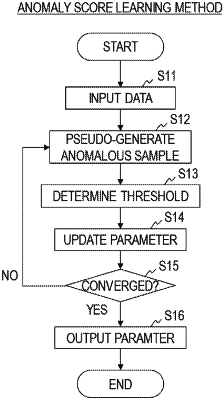| CPC G10L 25/78 (2013.01) [G10L 25/30 (2013.01); G10L 25/51 (2013.01)] | 3 Claims |

|
1. An anomaly sound detection apparatus to determine a target industrial device is in a normal state or in an anomalous state by calculating an anomaly score of an input sound data, the anomaly sound detection apparatus comprising processing circuitry configured to:
obtain an operational sound generated by the target industrial device;
obtain an input sound data from the operational sound;
calculate a first score from the first input sound data using an anomaly score function obtained by learning a plurality of normal sound samples;
calculate a second score using similarity between registered anomalous sounds and the input sound data and dissimilarity between registered normal sounds and the input sounds data;
calculate the sum of the first score and the second score as the anomaly score of the input sound data,
wherein, when a new anomalous sound is obtained, the processing circuitry further calculates the anomaly score by adding a third score to the sum of the first score and the second score, and the third score is obtained using similarity between the new anomalous sound and the input sound data and dissimilarity between registered normal sounds and the input sound data, thereby improving update efficiency of unsupervised anomaly sound detection apparatus without re-learning the anomaly score function.
|